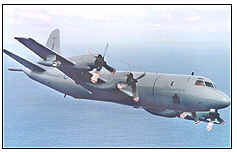
| Breakdowns
plague NZ's ageing Orions
|
| An Air Force P-3 Orion. |
| 04.12.2002 |
| By FRANCESCA MOLD political
reporter The country's ageing Air Force Orions are suffering an equipment failure every second time they take to the skies. The level of failure is such that it restricts the work of the 36-year-old aircraft, used for maritime patrols and peacekeeping support. Information supplied to the Herald under the Official Information Act showed that on average the Orions were experiencing a failure every second flight, based on an average flight time of six hours. The failures led to "operational restrictions of varying degrees", depending on the task and the kind of problem. The six-strong P-3 Orion fleet is expected to fly 2296 hours this financial year. Defence Force chief Air Marshal Bruce Ferguson said Air Force staff were working long hours, in trying conditions and frequently under considerable pressure, to keep the aircraft maintained and ready for duty. "They take no short cuts and will not compromise safety." But he admitted in his response to the Herald that in recent years the defects suffered by the Orions had increased. The systems with the most trouble were the radar, infrared detection, electronic support measures and data management. Air Marshal Ferguson said the radar and infrared detection system were complex and designed for a life of 15 years. But they were 18 years old and because some components were no longer made and repairs sometimes had to be done by the manufacturer in the United States they were becoming hard to maintain. The Government will decide before Christmas whether to give the Orions a multimillion-dollar upgrade of their sensor and mission-management systems. It has already approved an upgrade of the communications and navigation systems on the Air Force's C-130H Hercules transports. If similar improvements to the Orions are approved, the bill for the two upgrades could be $320 million. Last month the Cabinet agreed to replace the fault-prone Boeing 727-100s with two second-hand commercial jets at a cost of about $200 million. The replacement Boeing 757-200s will be modified and used for peace operations, medical evacuations, disaster and humanitarian relief, military exercises, VIP transport, Antarctic supply, and search and rescue. There has been growing concern that the Orions, used mostly for maritime surveillance, disaster relief reconnaissance and search and rescue, desperately need an overhaul. A 2001 Maritime Patrol Review found that imagery from the infrared system lacked sufficient resolution to identify vessels at night. This placed aircraft and ships at risk from potential threats. It also restricted the level of support the Orions could give the Ministry of Fisheries and Customs. The Boeing data management systems, also installed 18 years ago, were suffering from delays in the repair of components. Many of the failures were software-related and could at times hold up flights. The electronic support measures system was more than 35 years old and suffered from corrosion or oxidation of antennas, increasing need for circuit-board maintenance and an antenna that was no longer manufactured. Defence Minister Mark Burton said evaluation of options for upgrading the systems was well advanced. |